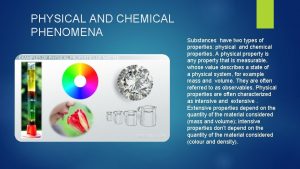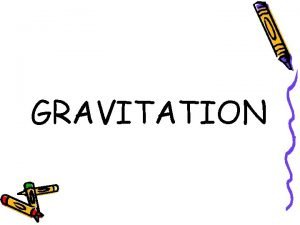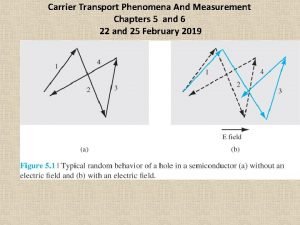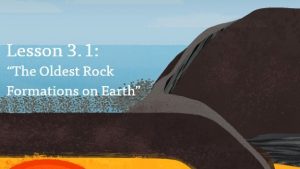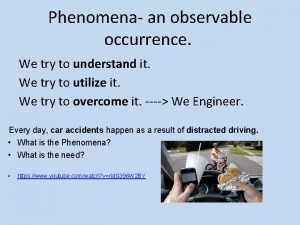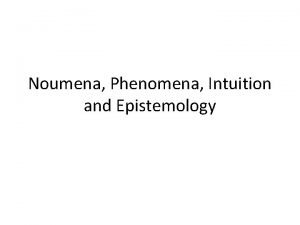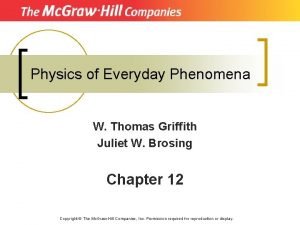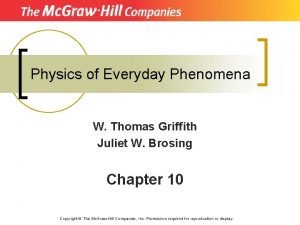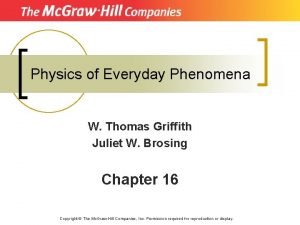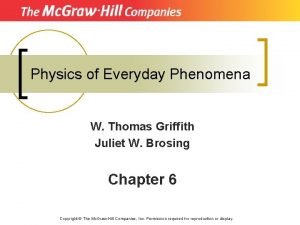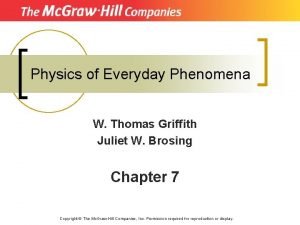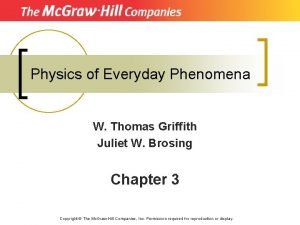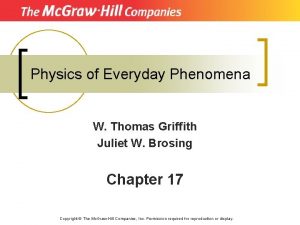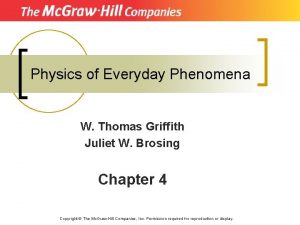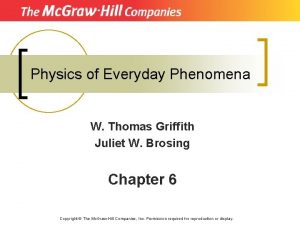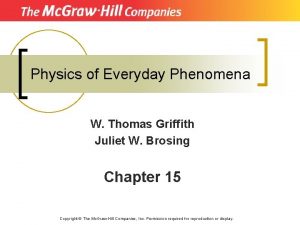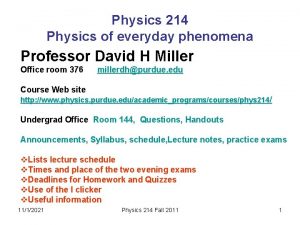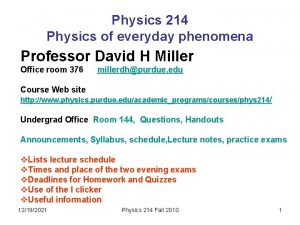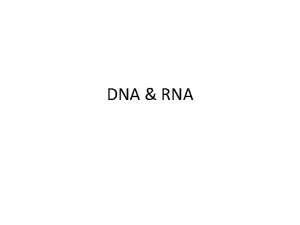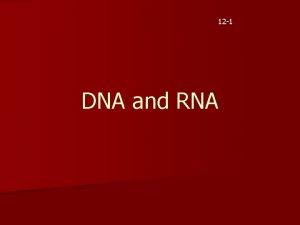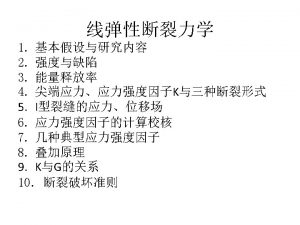Physics of Everyday Phenomena W Thomas Griffith Juliet




















- Slides: 20

Physics of Everyday Phenomena W. Thomas Griffith Juliet W. Brosing Chapter 5 Copyright © The Mc. Graw-Hill Companies, Inc. Permission required for reproduction or display.

Question 5. 1 An object is in uniform circular motion. Which of the following statements is true? A) Velocity = constant B) Speed = constant C) Acceleration = constant

Question 5. 2 The centripetal acceleration on an object in uniform circular motion A) is directed tangent to the circle B) points away from the center of the circle C) points toward the center of the circle

Question 5. 3 If the radius in which an object moves in uniform circular motion is tripled while the speed remains constant the centripetal acceleration is multiplied by a factor of A) 9 B) 3 C) 1 D) 1/3 E) 1/9

Question 5. 4 If the speed of an object in uniform circular motion is tripled while the radius remains constant the centripetal acceleration is multiplied by a factor of A) 9 B) 3 C) 1 D) 1/3 E) 1/9

Question 5. 5 A car is going around a banked curve at a high rate of speed. For the car not to skid, in which direction does the frictional force act? A) Up the plane. B) Down the plane. C) Directly towards the center of the curve.

Question 5. 6 In Olympic bobsled races, the sleds travel down the mountain at speeds up to 90 mph in ice coated tracks, navigating several sharp turns. If the bobsled is going too fast around a turn, it A) travels up the wall on the outside of the turn. B) remains in the middle of the track. C) travels up the wall on the inside of the turn.

Question 5. 7 As you make a right-hand turn in your car, you are pushed against the door to your left. This is because A) the centrifugal force pushed you to the left. B) no force pushed you to the right.

Question 5. 8 A ball is rolling around a curved horizontal track. Which of the paths represents the path of the ball when it leaves the track? A) B) C)

Question 5. 9 According to Kepler’s First Law, all planets have orbits about the Sun that are A) circles B) squares C) parabolas D) ellipses

Question 5. 10 The figure below shows the orbit of a comet about the sun. The comet has the greatest velocity when traveling A) from A to B. B) from B to C. C) from C to D. D) from D to E.

Question 5. 11 The figure below shows the orbit of a comet about the sun. If the area swept out by the line from the sun to the comet is equal when traveling from A to B and when traveling from D to E, what can we say about the time it takes A) the time to travel from A to B is greater than the time from D to E. B) the time to travel from A to B is the same as the time from D to E. C) the time to travel from A to B is less than the time from D to E.

Question 5. 12 If the distance to the moon were halved, then the force of attraction between the earth and moon would be A. quartered. B. halved. C. doubled. D. quadrupled.

Question 5. 13 The radius of plant Krow is twice that of Earth, yet the two planets have identical masses. Your weight on Krow, compared to your weight on Earth, is A. quartered. B. halved. C. the same. D. doubled. E. quadrupled.

Question 5. 14 The radius of plant Relpek is identical to that of Earth, yet the mass is twice that of Earth’s. Your weight on Relpek, compared to your weight on Earth, is A. quartered. B. halved. C. the same. D. doubled. E. quadrupled.

Question 5. 15 If an artificial satellite is orbiting about the Earth, between the Earth and the moon, how does its period of rotation compare to the moon’s period? A. greater. B. the same. C. less. D. don’t have enough information, depends on the satellite’s speed E. don’t have enough information, depends on the satellite’s mass

Question 5. 16 The Sun exerts a greater gravitational force on the Earth than the moon does, yet the moon is primarily responsible for the tides, why is this so? A. Nonsense, the moon is closer, so the gravitational force it exerts is stronger than the Sun’s. B. Nonsense, the Sun is responsible for the tides C. Tides are only created when the Sun and moon line up D. Because the variation of the gravitational force on the different sides of the Earth is greater due to the moon’s shorter distance from Earth.

Question 5. 17 Which is stronger, the earth's pull on the moon, or the moon's pull on the earth? A. the earth's pull B. the moon's pull C. they're the same

Question 5. 18 What position shown is the moon at when we view it as full? A. ‘above’ the Earth B. On the far side of the Earth (relative to the Sun) C. ‘below the Earth D. On the side closest to the Sun

Answer Key to Chapter 5 1) 2) 3) 4) 5) 6) 7) 8) 9) B C D A B B D 10) 11) 12) 13) 14) 15) 16) 17) 18) A B D A D C B
 Griffith thomas
Griffith thomas Pathologist and anthropologist
Pathologist and anthropologist A moose monikko
A moose monikko Some natural phenomena class 8 ppt free download
Some natural phenomena class 8 ppt free download Physical and chemical phenomena
Physical and chemical phenomena Phenomena related to refraction of light
Phenomena related to refraction of light Observable phenomena psychology
Observable phenomena psychology Contemporary phenomenon examples
Contemporary phenomenon examples Reference phenomenon in nlp
Reference phenomenon in nlp Reference phenomenon in nlp
Reference phenomenon in nlp Example of colloids
Example of colloids Gravitation is a natural phenomenon where:
Gravitation is a natural phenomenon where: Carrier transport phenomena
Carrier transport phenomena Anchor phenomena
Anchor phenomena Observable phenomena meaning
Observable phenomena meaning Importance of interfacial phenomena in pharmacy
Importance of interfacial phenomena in pharmacy Reoulox phenomena
Reoulox phenomena Global climate phenomena
Global climate phenomena Random phenomena
Random phenomena Noumenal
Noumenal Sinusoidal functions in real life
Sinusoidal functions in real life




